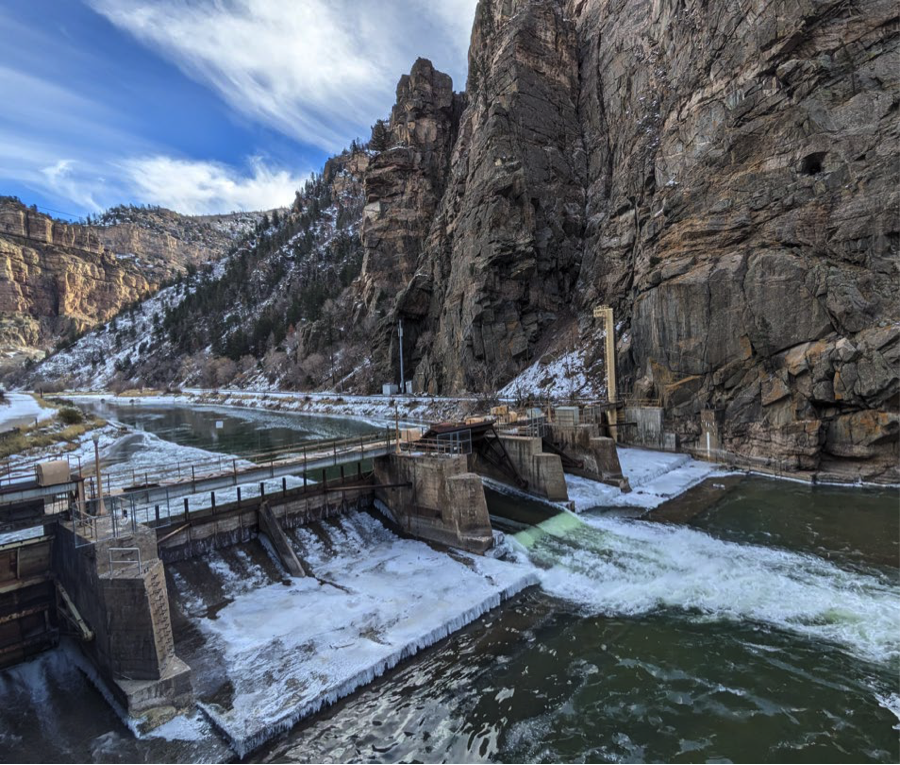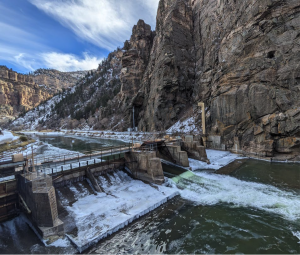Colorado River District secures instream flow agreement for its proposed Shoshone Water Right acquisition
The River District reached an agreement with the Colorado Water Conservation Board on Wednesday

Colorado Water Conservation Board/Courtesy Photo
The Colorado River District’s acquisition of the Shoshone water rights cleared a critical hurdle on Wednesday night as it entered into an instream flow agreement with the Colorado Water Conservation Board.
The agreement — which faced opposition from several Front Range water providers — will ensure that flows tied to the water rights will remain in the Colorado River for environmental benefits.
Supporters lauded the approval — which followed a 14-hour hearing in September, weeks of mediation and a six-hour hearing on Wednesday, Nov. 19 — as a historic, monumental and once-in-a-lifetime opportunity.
“Colorado almost never has an opportunity to secure a durable, permanent solution for the Colorado River, and certainly not with the water right as senior, as foundational, and iconic as the Shoshone,” said House Speaker Julie McCluskie, D-Dillon. “What is before you is more than a transaction. It is a chance to protect a defining piece of our river system permanently for the betterment of our entire state.”
The Colorado River District is seeking to acquire the Shoshone water rights — tied to a hydropower plant on the Colorado River in Glenwood Canyon — from Xcel Energy for $99 million. The rights — which include a 1905 senior right tied to the Shoshone Power Plant and a secondary, junior right established in 1929 for other water users, including Front Range providers — are among the oldest and largest non-consumptive rights on the Colorado River.
The inclusion of the instream flow agreement will help ensure the Colorado River District maintains the status quo on the river by allowing some water to remain in the river for environmental purposes, regardless of the power plant operations.
“This agreement strengthens water security for hundreds of communities within our state and represents a proactive, durable solution for the 40 million people who rely on the Colorado River downstream,” said Sen. Marc Catitlin, a Montrose Republican who also serves as president of the Colorado River District board, in a news release. “The Shoshone Water Rights Preservation Project keeps the river as whole as possible, keeping water in its natural basin and safeguarding this lifeline for generations to come.”

Despite squabbling between Colorado’s Western Slope and Front Range over some tenets of the agreement, this one critical element of the instream flow acquisition was uncontested and helped secure the Colorado Water Conservation Board’s ultimate approval.
“It’s pretty incredible that there’s no objection to the environmental aspects of this flow,” said Taylor Haws, who represents the Colorado River Mainstem on the Colorado Water Conservation Board.
Less scrolling. More knowing.
Sign up for daily or weekly newsletters at SummitDaily.com/newsletter
Jessica Brody, general counsel for Denver Water, said that even in their contesting of the agreement, the Front Range entities supported the Colorado River District’s “stated objective of preserving the status quo.”
“Our ultimate goal is to get to a negotiated resolution that is a win for the River District and the coalition of stakeholders who have worked so hard to get to this point, and a win for the environment in this critical stretch of the Colorado River, and frankly, a win for all Colorado water users who rely on this essential resource by ensuring predictable river administration that avoids injury to existing water rights,” Brody said.
Trying to find a consensus, compromise
Denver Water, Northern Water, Aurora Water and Colorado Springs Utilities — all of which rely on transmountain diversions from the Colorado River basin to supply water to their customers — contested the instream flow agreement, arguing that mishandling of the rights could risk their ability to meet customer water demands.
After a 14-hour hearing in September, the Colorado Water Conservation Board requested that its staff, the Front Range water providers and Colorado River District enter into mediation and attempt to reach a consensus on the contested elements of the agreement.
“Despite considerable effort, a final settlement was not reached,” said Robert Viehl, chief of the Colorado Water Conservation Board’s stream and lake protection section, on Wednesday.
Viehl added that the Colorado Water Conservation Board staff worked with the River District to revise the instream flow agreement to address some of the Front Range parties’ concerns and those expressed by the board in September.

Still, one key issue remained contested between the River District and Front Range entities: who has control over exercising the Shoshone rights. The River District’s proposed instream flow agreement included a “co-management strategy” that would have it collaborate with the Colorado Conservation Board.
Granting the River District co-management of the Shoshone rights was a non-negotiable for many of the Western Slope stakeholders that have been financially supporting the acquisition.
“The joint management proposal is a safeguard that ensures Western Slope interests are not pushed aside,” said Bobbie Daniel, a Mesa County commissioner. “The River District has earned its seat through decades of stewardship, deep technical capacity, and a lived understanding of Western slope hydrology that no distant utility can replicate. Joint management — it’s not a luxury — it’s the only arrangement that respects the communities who live with the consequences of these decisions every single day.”
Without this joint management, Daniel said Mesa County would withdraw its support for the acquisition. This sentiment was shared by other individuals — including representatives of Garfield, Eagle, Summit and Grand counties — on Wednesday.
Nina Waters, Summit County commissioner, said that co-management, as proposed in the agreement, was meaningful and provided opportunities for collaboration among all stakeholders.
“Future stewardship of an instream flow that is critical to all of us who work and play on the Western Slope,” Waters said. “For that reason, co-management of the water rights included in the donation is a fundamental element of our county’s political and financial support…This collaboration represents one of the rare spaces where incredibly diverse communities and leaders across the Western slope come together around a quintessential resource that underpins our economies, our recreation, and our ability to thrive.”
The contesting Front Range providers sought to have sole management authority reside with the Colorado Water Conservation Board, arguing that the proposed shared authority was unprecedented.
“We have a principled policy disagreement concerning whether the (Colorado Water Conservation Board or the River District should have ultimate decision-making authority to modify or relax the (Instream flow) call in times of crisis, including those foreseeable crises like extreme drought, forest fire, cyber attack on a treatment plant, as well as the unknown unknowns that we cannot even envision sitting here today,” Brody said.
“The proposed instream flow use agreement before you today is unprecedented, both because of the statewide magnitude of the water rights at issue and because you are being asked to forever cede this board’s exclusive authority to make future decisions about these most consequential water rights,” Brody added.
However, this notion was contested by some of the board members and legal representation.
“There’s nothing in statute that would prohibit us from having another entity help us with an acquired water right, allowing another entity to — especially when that entity owns the water right — decide when to call or not to call that water right,” said Jen Mealy, assistant attorney general and counsel for the Colorado Water Conservation Board staff.

Director John McClow, who represents the Gunnison-Uncompahgre River on the Colorado Water Conservation Board, said the agreement contemplated not a ceding of authority to the River District but a partnership.
“My belief is we are receiving a donation of a water right with certain conditions and that’s just like any other release of a water right or any other exercise of an end stream flow, the donor can put conditions,” McClow said.
To address some of the Front Range providers’ concerns, the version presented and approved in November mirrored and gave nods to existing water agreements as well as provided more details on how mandatory, voluntary and discretionary calls would be made as part of the co-management.
Andy Mueller, general manager of the River District, said the co-management provision was “designed to create a process that is responsive to anyone’s needs on the river.”
“It could be Front Range. It could be a West Slope water user. It could be a large city. It could be a small city. It could be an irrigation district that’s running into trouble,” Mueller said.
What’s next for the Shoshone acquisition?
With the instream flow agreement secured, the River District and the Colorado Water Conservation Board will begin the water court process to add instream flow use to the Shoshone water rights. The Colorado Water Court has the final say over the acquisition and will determine which historic flow regime is tied to the Shoshone water right — a decision that has been heavily debated between the River District and Front Range water providers.
To close the transaction, the River District will also seek approval from the Colorado Public Utilities Commission and secure the full acquisition funding. Thirty-two Western Slope entities — including utilities and municipalities — have pledged over $37 million toward the district’s acquisition. Another $20 million was pledged by the Colorado Water Conservation Board, $20 million from the River District’s board, and $40 million from the federal government, which was granted in the waning days of the Biden administration and frozen in the first days of the second Trump administration.

Support Local Journalism

Support Local Journalism
As a Summit Daily News reader, you make our work possible.
Summit Daily is embarking on a multiyear project to digitize its archives going back to 1989 and make them available to the public in partnership with the Colorado Historic Newspapers Collection. The full project is expected to cost about $165,000. All donations made in 2023 will go directly toward this project.
Every contribution, no matter the size, will make a difference.










